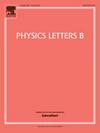QED 级联的有限束流效应
IF 4.3
2区 物理与天体物理
Q1 ASTRONOMY & ASTROPHYSICS
引用次数: 0
摘要
根据量子电动力学(QED)理论的预测,QED 级联中涉及的光子发射和光对产生主要发生在一个前向锥体中,其沿入射粒子矩的有限角散布Δθ∼1/γi。在激光驱动的 QED 级联中,由于粒子的超相对论洛伦兹因子 γi≫1 ,这种有限的束流效应被假定为可以忽略不计。我们开发了一种能量和角度解析的粒子跟踪代码,解析了每个 QED 事件中出射粒子的能量谱和动量谱,从而大大提高了模拟结果与精确 QED 结果之间的一致性。我们研究了由两个反向传播的圆偏振激光脉冲驱动的 QED 级联,结果表明,尽管窄束流很难影响级联的早期形成,但它可以通过累积来有效抑制级联的长期增长。对于长度超过10个激光周期的QED级联,有限光束效应会使最终成对率降低10%以上,尤其是在超高强度ξ>600下。本文章由计算机程序翻译,如有差异,请以英文原文为准。
Finite beaming effect on QED cascades
The quantum electrodynamic (QED) theory predicts the photon emission and pair creation involved in QED cascades occur mainly in a forward cone with finite angular spread Δ θ ∼ 1 / γ i γ i ≫ 1 ξ > 600
求助全文
通过发布文献求助,成功后即可免费获取论文全文。
去求助
来源期刊

Physics Letters B
物理-物理:综合
CiteScore
9.10
自引率
6.80%
发文量
647
审稿时长
3 months
期刊介绍:
Physics Letters B ensures the rapid publication of important new results in particle physics, nuclear physics and cosmology. Specialized editors are responsible for contributions in experimental nuclear physics, theoretical nuclear physics, experimental high-energy physics, theoretical high-energy physics, and astrophysics.
 求助内容:
求助内容: 应助结果提醒方式:
应助结果提醒方式:


